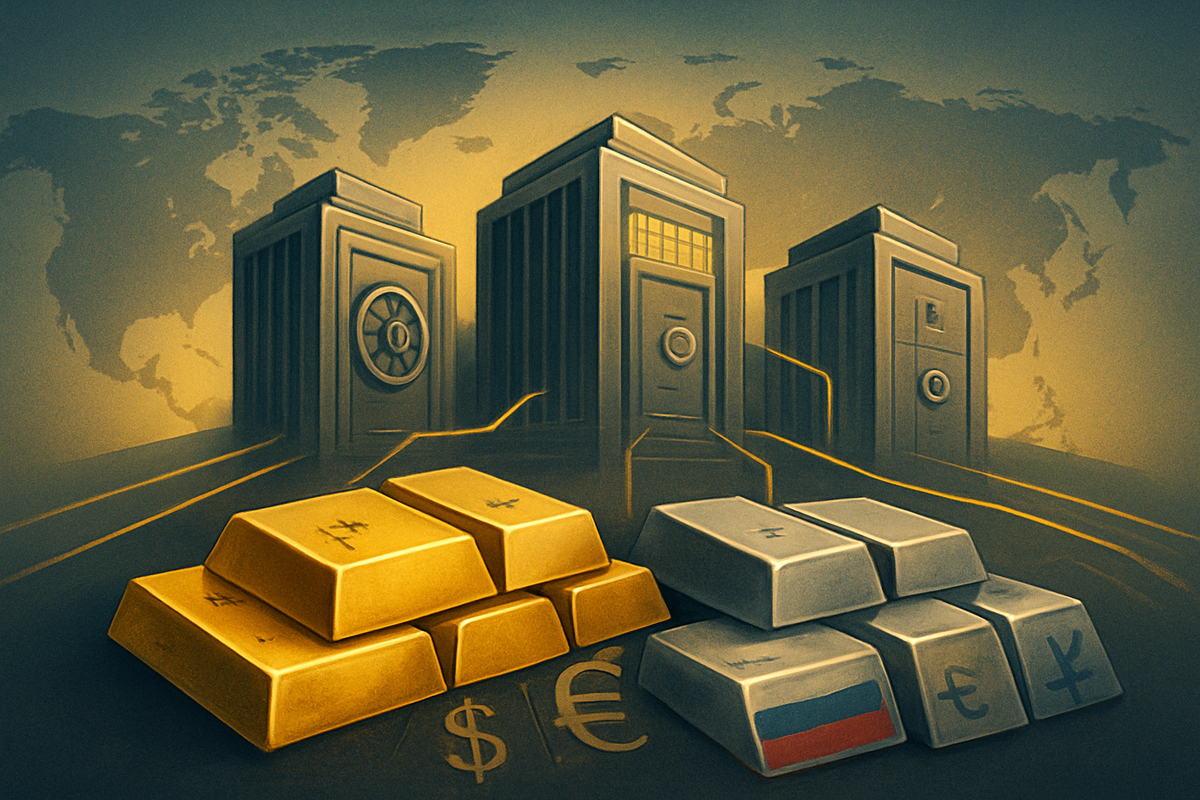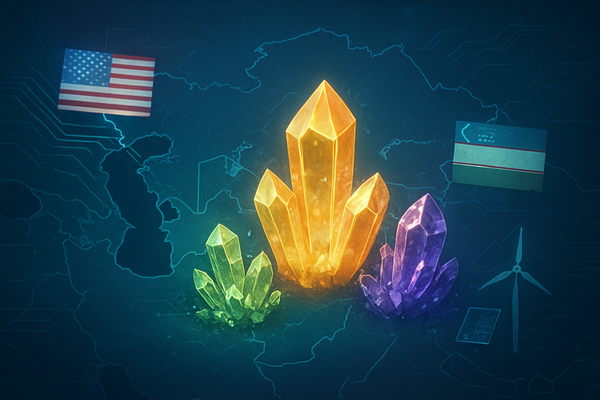The New Gold Rush: Central Banks Pivot to Precious Metals as Russia Pioneers Silver in De-dollarization

The global financial system is experiencing a profound transformation as central banks worldwide dramatically increase their accumulation of precious metals, primarily gold. This strategic shift is driven by a complex interplay of geopolitical uncertainties, persistent inflation concerns, and a concerted global effort towards de-dollarization. In a groundbreaking move, Russia is not only a leading accumulator of gold but is also explicitly incorporating silver into its state reserves as a key component of its de-dollarization initiatives. These actions, particularly prominent in late 2025, signal a fundamental re-evaluation of reserve management with significant macroeconomic implications, challenging the long-standing hegemony of the U.S. dollar.
This widespread pivot towards tangible assets reflects a growing unease with traditional fiat currencies and a desire for greater financial sovereignty. As nations seek to insulate themselves from geopolitical risks and the perceived weaponization of the dollar through sanctions, gold and now silver are re-emerging as foundational pillars of national wealth and stability. The implications for global currency dynamics, commodity markets, and international trade are vast, pointing towards a more multipolar financial future.
A Global Gold Rush and Russia's Silver Gambit
The trend of central banks accumulating precious metals, especially gold, has intensified significantly in recent years, showing no signs of abating as of late 2025. Net gold acquisitions by central banks surpassed 1,000 tonnes annually in 2022, 2023, and 2024, marking the most sustained period of central bank gold accumulation since the end of the Bretton Woods system in 1971. This robust accumulation has continued into 2025, with 634 tonnes added year-to-date by the third quarter. A World Gold Council survey from 2025 indicates that an overwhelming 95% of central banks anticipate global gold reserves to increase over the next 12 months. Globally, central banks now collectively hold over 36,000 tonnes of gold as of Q2 2025.
Key purchasing nations in recent years up to late 2025 include Poland (which added 67.2 tonnes year-to-date in Q3 2025), China (19 tonnes in H1 and 5 tonnes in Q3), India (nearly 600 kilograms between April and September 2025, bringing total reserves to 880 tonnes), Turkey, Kazakhstan, Brazil, and the Czech Republic. The motivations are clear: diversification away from the U.S. dollar, a hedge against inflation and economic instability, and the desire for sanctions-immune assets. The freezing of Russia's foreign reserves in 2022 served as a stark reminder of these vulnerabilities.
In a significant departure from historical central bank practices, Russia has formally and explicitly announced its intention to include silver in its strategic state reserves. This groundbreaking move, outlined in Russia's Draft Federal Budget for 2025-2027, allocates approximately $535 million for precious metals acquisition, explicitly listing silver alongside gold, platinum, and palladium. This decision is seen as "monumental" and marks the first time a central bank has publicly declared silver purchases for state reserves during the current precious metals bull market. Russia's silver strategy is an integral part of its aggressive de-dollarization agenda, aiming to reduce reliance on the U.S. dollar and Western financial systems, a resolve intensified by recent geopolitical sanctions. At the 2024 BRICS Summit, Russia also announced a plan for BRICS countries to establish a platform for directly trading precious metals, including gold, silver, and diamonds, without the use of U.S. dollars, with implementation set to commence in 2025.
The acceleration of central bank gold purchases began after 2018 and surged dramatically from 2022 onwards. Russia's silver strategy became explicit with the outlining of budget allocations for silver acquisition in its Draft Federal Budget, reported in late 2024/early 2025. This sustained institutional demand has contributed to gold prices surging to unprecedented record highs in 2025, briefly touching $3,977 per troy ounce. Russia's explicit entry into the silver market has acted as a major bullish catalyst, with silver prices surpassing $42/oz in September 2025, up nearly 28% year-to-date and outperforming gold. The impact on currency markets is closely tied to the de-dollarization trend; central bank gold accumulation can indirectly weaken the USD, which has seen a 12% depreciation during 2025.
Companies Poised to Win or Lose in the Shifting Sands
The global pivot towards precious metals and de-dollarization creates distinct winners and losers across various industries.
Gold and Silver Mining Companies are among the primary beneficiaries. Higher precious metal prices directly translate to significantly improved revenue streams and expanded profit margins. This bullish environment enhances cash flow, enables higher dividend payouts, and can lead to substantial stock price appreciation. Major players like Newmont Corporation (NYSE: NEM), the world's top gold miner, and Barrick Gold (NYSE: GOLD), the second-largest producer, are well-positioned to capitalize. Agnico Eagle Mines (NYSE: AEM), known for its low-cost production, is also set to see significant profit increases. In the silver sector, companies like First Majestic Silver Corp. (NYSE: AG) have already reported substantial revenue increases, buoyed by rising silver prices. Coeur Mining Inc. (NYSE: CDE), with diversified gold and silver operations, and Polymetal International, operating in Russia and Kazakhstan, will also benefit. Royalty and streaming companies like Wheaton Precious Metals Corp. (NYSE: WPM) and Franco-Nevada Corporation (NYSE: FNV) stand to gain significantly, as they acquire future production at fixed low costs, profiting from rising spot prices without direct operational risks.
Precious Metal Refiners will also experience increased transaction volumes. Companies like Elemetal and United Precious Metal Refining, Inc., which process raw materials into bullion bars and coins, will see higher demand for their services and increased sales of physical metal products. Regulatory changes like Basel III, classifying gold as a Tier 1 asset, further enhance the focus on physical gold, benefiting these refiners.
Conversely, Financial Institutions Heavily Exposed to U.S. Dollar Dominance face significant challenges. U.S. banks and financial institutions that rely on dollar-denominated trade and transactions may experience a decline in revenues as more international trade bypasses the dollar. The diminished centrality of the SWIFT payment system could lead to reduced business for institutions deeply integrated into this system. Furthermore, if foreign central banks reduce their holdings of U.S. Treasury bonds, the U.S. government could face higher borrowing costs, potentially impacting all financial sectors.
Companies with Significant Exposure to the U.S. Dollar (outside of exports) could also face adverse impacts. A significant weakening of the dollar, spurred by de-dollarization, would make imports more expensive for U.S.-based companies, increasing operational costs. Multinational corporations might see lower repatriated earnings from foreign operations if those earnings are in stronger local currencies. Companies that rely on stability in global currency exchange rates might face increased volatility and uncertainty.
A Wider Significance: Geopolitical Shifts and Monetary Realignments
The dual trends of central bank precious metal accumulation and Russia's de-dollarization are unfolding within several broader global shifts, signaling a profound realignment of the international monetary system.
This movement is deeply intertwined with Geopolitical Shifts towards a multipolar world order. Tensions between major powers and the increasing use of "weaponized finance" (financial sanctions) have prompted nations to reassess their financial vulnerabilities. The freezing of Russia's foreign reserves demonstrated the risk of holding assets offshore, making gold, as a tangible and sanctions-resistant asset, increasingly attractive for financial sovereignty.
There's an Evolving Trust in Fiat Currencies, particularly the U.S. dollar. Concerns over persistent inflation, ballooning sovereign debt levels, and the sustainability of U.S. borrowing trends are eroding confidence in fiat currencies. Central banks perceive gold as a protection against currency devaluation and an unreliable global monetary landscape. This has led to a Search for Alternative Reserve Assets, with gold now surpassing the Euro as the second-largest component of international reserves globally.
The Potential Ripple Effects are far-reaching. In Commodity Markets, de-dollarization is leading to a growing proportion of energy and other raw materials being priced and settled in non-dollar contracts. A weakening dollar could lead to higher dollar-denominated commodity prices, impacting supply patterns. International Trade is seeing increased use of national and regional currencies in bilateral agreements, particularly among BRICS nations, potentially leading to a more fragmented and complex global financial system. For Global Economic Stability, a significant reduction in dollar usage could lead to a broad depreciation of the U.S. dollar, increased U.S. borrowing costs, and potentially higher inflation. A rapid collapse of dollar dominance could trigger significant currency volatility and economic instability globally.
These trends carry significant Regulatory or Policy Implications. De-dollarization efforts, especially by Russia, aim to circumvent or weaken the effectiveness of U.S. and Western sanctions. The accumulation of gold provides an asset that cannot be easily frozen. This is fostering New Trade Agreements and Blocs that prioritize non-dollar currency settlements, potentially leading to the formation of regional financial spheres of influence. Existing international institutions like the IMF and World Bank could also be challenged by increased financial fragmentation.
Historically, these shifts evoke Historical Precedents like the Gold Standard (1870s-1971) and the Collapse of Bretton Woods (1971-1973). The current central bank gold buying spree is unprecedented since Bretton Woods, signaling a more fundamental reassessment of the global monetary landscape than previous challenges to the dollar's dominance, such as the introduction of the Euro.
What Comes Next: A Multipolar Financial Horizon
The intertwined trends of central bank precious metal accumulation and Russia's de-dollarization point towards a significant evolution in the global financial system, with both short-term and long-term implications.
In the short-term (late 2025 - early 2026), continued central bank demand will likely exert upward pressure on precious metal prices. Gold has established a new floor around $4,000 per ounce, with forecasts suggesting further gains. Silver, benefiting from both safe-haven demand and growing industrial applications, is also expected to see significant upside. Russia's aggressive shift to national currencies like the ruble and yuan for trade settlements will continue, further promoting alternative payment systems like Mir and SPFS. This ongoing diversification will contribute to increased volatility in other asset classes as capital shifts.
The long-term outlook suggests a more diversified and potentially multipolar global financial system. The sustained accumulation of gold and the explicit inclusion of silver in reserves signal a structural shift where tangible assets play a more central role. This challenges U.S. dollar dominance, with 73% of central banks expecting lower U.S. dollar holdings in global reserves over the next five years. Successful de-dollarization, particularly if adopted by other nations, could diminish the U.S.'s ability to use sanctions as a foreign policy tool and reduce its economic leverage. The development of new financial architectures, potentially involving gold-backed digital currencies or currency baskets, could redefine global trade and finance.
Strategic Pivots are already underway. Governments are diversifying reserves, promoting local currency trade agreements, and strengthening alliances like BRICS+. Central banks are actively managing gold reserves for risk management, developing Central Bank Digital Currencies (CBDCs), and prioritizing domestic gold storage. Corporations will need to enhance currency risk management, adapt to new payment systems, and build supply chain resilience to navigate increased volatility and fragmented financial flows.
Several Potential Scenarios exist:
- Gradual De-dollarization and Increased Multipolarity (Most Likely): A steady erosion of the U.S. dollar's dominance without a sudden collapse. Gold and silver prices would likely continue their bullish trajectory, and the U.S. dollar's share in global reserves would continue to decline.
- Accelerated De-dollarization and Fragmentation: Triggered by a major crisis, leading to a rapid and disorderly shift. This could result in heightened geopolitical tensions, significant global inflationary pressures, and a potential slowdown in global economic growth. Gold prices would surge dramatically as a primary safe haven.
- U.S. Dollar Resilience/Reassertion: Despite efforts, the depth and credibility of U.S. financial markets allow the dollar to retain its dominant position. Gold demand might stabilize, but its role as a diversification tool would persist.
Wrap-Up: A New Era of Financial Sovereignty
The combined trends of central bank precious metal accumulation and Russia's de-dollarization represent a profound and potentially transformative period for global finance. The key takeaway is a concerted global movement towards greater financial autonomy and diversification away from an over-reliance on the U.S. dollar. Central banks are demonstrating strong confidence in precious metals as foundational assets in an era defined by geopolitical uncertainty and evolving economic structures, with Russia playing a leading role in expanding this confidence to include silver.
Moving forward, the market will likely be characterized by sustained institutional demand for gold and silver, providing a structural floor for prices. While the U.S. dollar's immediate dethronement is not anticipated, its long-term dominance is being actively challenged, leading to a more multipolar and fragmented international monetary system. The significance of these trends lies in their potential to reshape global power dynamics, enhance monetary sovereignty for nations, and build resilience against future financial shocks.
What Investors Should Watch For in the Coming Months:
- Central Bank Gold Buying Reports: Monitor quarterly reports for continued insights into the pace and geographic distribution of central bank gold purchases.
- Geopolitical Developments: Observe any escalations or de-escalations of global tensions, as these directly influence de-dollarization efforts and safe-haven demand.
- Monetary Policy Decisions: Pay attention to interest rate decisions from major central banks, particularly the U.S. Federal Reserve, as lower rates generally boost the appeal of non-yielding precious metals.
- De-dollarization Metrics: Watch for changes in the U.S. dollar's share in global foreign exchange reserves and international trade settlements, especially the increasing use of the Chinese yuan and other national currencies.
- Silver Market Dynamics: Beyond gold, keep a close eye on silver's performance, given its dual role as a precious metal and a critical industrial commodity in green energy technologies.
By understanding these interconnected trends, investors can better position their portfolios for resilience and potential growth in a transforming global financial landscape.
This content is intended for informational purposes only and is not financial advice



